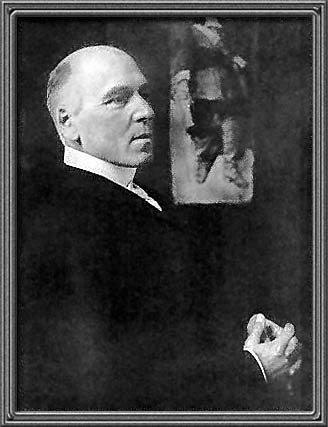
Howard Pyle
Born in Wilmington, Delaware, in 1853, Pyle was the son of William Pyle, a leather manufacturer. His mother, Margaret Pyle, stimulated his artistic interests by reading to him, making available fine books and illustrated periodicals, and encouraging him to write and draw. She also imparted a strong sense of both spirituality and imagination, and the connection between the two that characterized her Swedenborgian religious beliefs.
Pyle studied art briefly in Philadelphia and, at age nineteen, began giving art lessons in Wilmington. In 1876 he published his first illustrated poem in the July issue of Scribner's Monthly. Over the next thirty years, Pyle's more than three thousand illustrations appeared not only in numerous books, but also in major magazines, including St. Nicholas, Harper's Weekly, Harper's Monthly, and McClure's. For many publications, he also wrote the stories he illustrated. His work encompassed historical fiction and non-fiction, romance, European medieval themes, adventure, folk and fairy tales, poetry, and whimsical narratives for children.
Although Pyle spent a few years in New York City, he lived most of his life in his teaching studio in Wilmington. He taught at the Drexel Institute of Art, Science and Industry (now Drexel University) and held a summer school in Chadds Ford, Pennsylvania. Pyle's "students" were mostly practicing illustrators, many of them already published, who came for critiques rather than for lessons as such. Pyle also exhibited and lectured throughout the United States. In 1910, determined to improve his mural painting by studying those of the Italian Renaissance masters, Pyle sailed for Italy. A year later he died in Florence, where he is buried.
With increasing literacy and leisure time, the late nineteenth century saw an efflorescence of illustrated books and magazines. Pyle brought to his work an immediacy often lacking in earlier American illustration. A love of theater helped inspire his philosophy and practice of illustration. Through his "theory of mental projection," as he called it, Pyle intensely imagined the experience he was depicting. By studying facial construction, he perfected ways of portraying the essence of human feelings. Devices such as exaggerated gestures, upward viewpoints to suggest sweeping action, and evocative lighting to create mood all lent a riveting quality to his work.
A masterful colorist, Pyle imbued his paintings and drawings with drama and emotion. His dedication to accurate historical detail, combined with a Romantic sensibility, lent a convincing realism to his scenes. Pyle used these talents to create compelling illustrations that still give us, as he once noted, "a vivid flash of real truth.